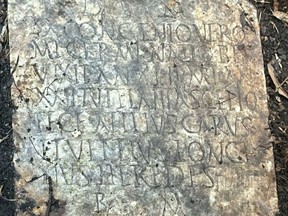
Contents of the article
NEW ORLEANS – A New Orleans family clearing out their overgrown backyard made an extremely unusual discovery: buried under the weeds was a mysterious marble plaque with Latin letters spelling out the phrase “spirits of the dead.”
Advertisement 2
Contents of the article
“The fact that it was in Latin really gave us pause, right?” said Danielle Santoro, an anthropologist at Tulane University. “I mean, you see something like this and you say, 'Okay, this is an unusual thing.'
Contents of the article
Contents of the article
Intrigued and slightly alarmed, Santoro approached fellow archaeologist Susanna Lusnia, who quickly realized that the slab was the 1,900-year-old tomb of a Roman sailor named Sextus Congenius Verus.
“When I first saw the image that Danielle sent me, I actually got chills because I was just shocked,” Lusnia said.
Further investigation by Lusnia revealed that the tablet had been missing from the Italian museum for decades.
Sextus Congenius Verus died at the age of 42 of unknown causes, after serving for more than two decades in the imperial navy on a ship named after the Greco-Roman god of medicine, Asclepius. The tombstone names the sailor “distinguished” and was commissioned by two people referred to as his “heirs,” who were likely shipmates since Roman military officers could not marry at the time, Lusnia said.
Contents of the article
Advertisement 3
Contents of the article
The tablet was located in an ancient cemetery with about 20 graves of military personnel found in the 1860s in Civitavecchia, a coastal region in northwestern Italy, about 30 miles (48 kilometers) from Rome. Its text was recorded in 1910 and included in a catalog of Latin inscriptions, which noted that the tablet's whereabouts were unknown.
The tablet was later documented at the National Archaeological Museum in Civitavecchia before World War II. But the museum was “largely destroyed” during Allied bombing and took decades to rebuild, Lusnia said. Museum staff confirmed to Lusna that the tablet had been missing for decades. Its recorded dimensions—1 square foot (0.09 square meters) and 1 inch (2.5 centimeters) thick—matched the size of the sign found in Santoro's backyard.
Advertisement 4
Contents of the article
“The DNA couldn’t be better,” Lusnia said.
She said the FBI is in talks with Italian authorities about repatriating the tablet. An FBI spokesman said the agency could not respond to requests for comment during the government shutdown.
The latest twist in the story suggests how the tablet ended up in New Orleans.
As reports of the discovery began to circulate in the media this week, Erin Scott O'Brien said her ex-husband called her and told her to watch the news. She immediately recognized the piece of marble, which she had always considered “a cool piece of art.” They used it as a garden decoration and then forgot about it before selling the house to Santoro in 2018.
“None of us knew what it was,” O'Brien said. “We watched the video in shock.”
O'Brien said she received the tablet from her Italian grandparents, a New Orleans native who was stationed in the country during World War II.
Perhaps no one will be more delighted by the discovery of the tablet than Sextus himself. In Roman culture, tombstones played an important role in preserving the heritage of even ordinary citizens, Lusnia said.
“There’s so much talk about Sextus Congenius Vera these days,” Lusnia said. “If there is an afterlife and he's in it and he knows, he's very happy because that's what a Roman wants – to be remembered forever.”
Contents of the article







